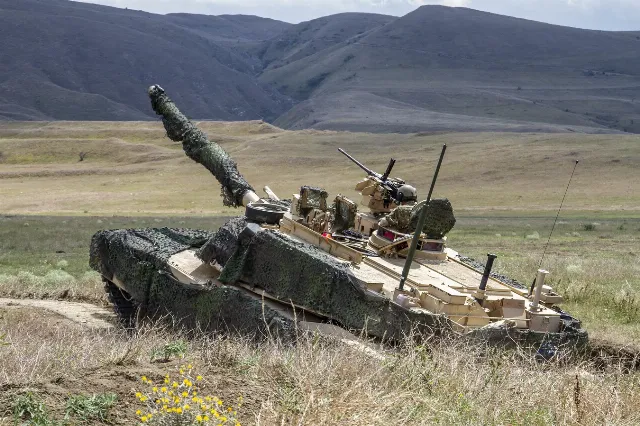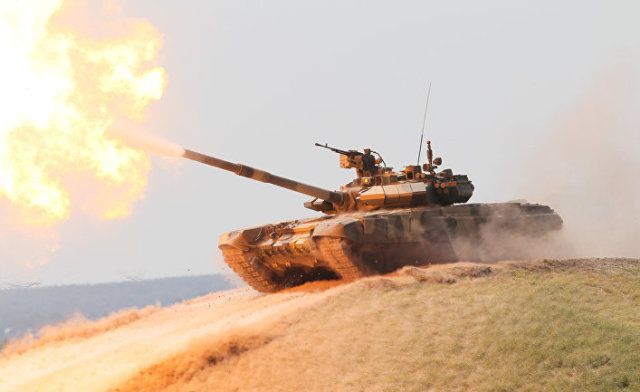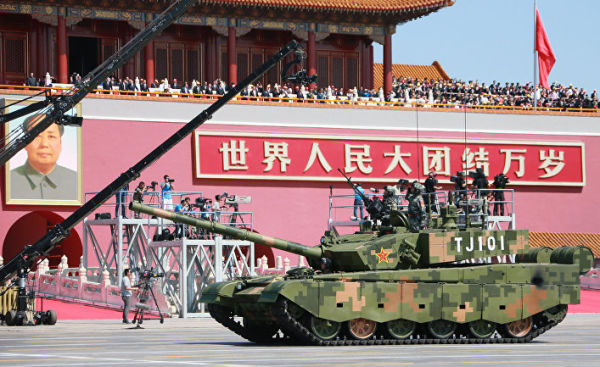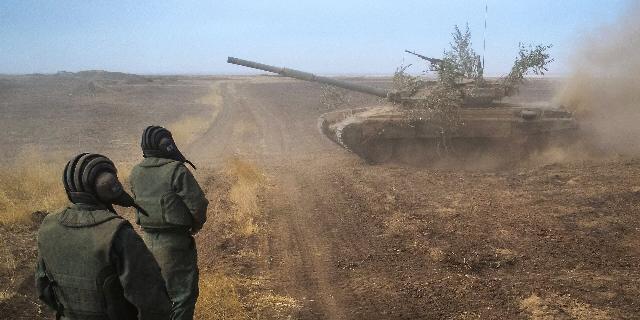The latest and best example in the line of Chinese tanks is respected by foreign observers. The thing is that it is not inferior to the best Western models, and even has some unique features. But will it stand up against the American Abrams and the Russian T-90?
Sebastien Roblin
China has a lot of tanks. About eight or nine thousand. Who else would need such a huge amount?
For example, the United States. And Russia. (Note that we have included canned tanks in warehouses and a reserve in the total figure. The number of tanks in the active army is in any case less.)
However, most Chinese tanks are old models, especially the Type 59 and Type 69, which are partly a direct copy of the Soviet T-54 machine of the 1950s. There are so many of these tanks that one day I came across one of them on a playground in Tianjin, where it became a toy for children.
However, the last and best example in this line, the Type 99 tank, commands healthy respect from foreign observers, although it has never been exported or used in combat. The reason is simple: in terms of its tactical and technical characteristics, it is not inferior to the best Western models, and also has some unique features.
Today we will look at how the Type 99 looks in comparison with its two most important contemporaries, such as the American M1A2 Abrams tank and the Russian T-90.
Before we dive into the technical details, we should answer this question: does China even need tanks? The question is quite reasonable, because China's main military efforts are concentrated in the direction of the Pacific Ocean.
Some may ask: what are the chances that the American M1 Abrams tanks will ever come together in battle with the Chinese Type 99? At the same time, it's worth thinking about this: will these armored vehicles be able to swim across the Pacific Ocean and exchange shots somewhere in the Scarborough Reef area?
 |
| The American Abrams tank. |
| Source: © CC BY-SA 2.0 / The U.S. Army |
But jokes aside. This is extremely unlikely, except for the scenario of an amphibious operation for some computer game. On the other hand, Taiwan is showing interest in buying Abrams tanks, and another 60 such vehicles are in service with Australia. So never say never.
However, this issue becomes more relevant if you think about the Russian T-90. Moscow now has good relations with Beijing, but these countries are not close allies. There is a long common border between them, and in the late 1960s they almost went to war with each other.
Most importantly, Russia supplies its weapons and military equipment to India and Vietnam, including systems that will clearly be used against the Chinese army in the event of a conflict. For example, these are BrahMos cruise missiles, and... yes, over one thousand T-90 tanks, many of which are deployed along the Indian border in the Himalayas.
In 1962, China went to war with India over this border, and in 1979 began a war with Vietnam in order to punish it for its confrontation with the Khmer Rouge regime in Cambodia, which enjoyed Chinese support. (Vietnam also wants to order the T-90.)
Today, the Chinese military insists that India, which may become a superpower in the future, poses a threat to China. Therefore, they are conducting large-scale militarization of border areas near India and building roads so that heavy military equipment can pass through high mountains. China is also establishing allied relations with Pakistan, which has repeatedly fought with India, and from time to time supplies it with military equipment.
Finally, one should think about a possible civil war or the collapse of the government in North Korea. What kind of policy Beijing will pursue in this case is a trillion-dollar question, but according to one scenario, the Chinese ground forces should intervene and restore order in North Korea. And this threatens to clash with Korean troops.
Thus, although no one needs a real armed conflict and in most cases it will have the opposite effect for all participants (like most other wars), there are some situations in which tank battles can still take place on the borders of China, in particular, against Russian-made tanks.
But enough about politics, let's move on to the rumbling death machines!
First, let me introduce the rivals...
Of course, the Abrams is a classic American machine that defeated Iraqi tank forces armed with Soviet tanks during the Persian Gulf War in 1991. At the same time, the Americans did not lose a single tank from enemy fire. The Abrams is not a new tank, but the ground forces are constantly improving its ammunition, armor protection and detection devices so that it keeps up with the times.
 |
| T-90 tank at the First International Forum "Technologies in Mechanical Engineering-2010". |
| Source: © RIA Novosti, Alexey Kudenko | Go to the photo bank |
The T-90 is the first Russian tank to appear after the Cold War. It is not a match for the Abrams, but it still has important characteristics in terms of accuracy of fire and armor protection. This is especially true for machines equipped with a new generation of dynamic protection. Currently, Russia is adopting a fundamentally new T-14 tank, but so far its main fighting force remains 550 T-90A tanks.
Moscow has created an upgraded T-90AM tank, but has not yet started mass production of this machine. However, it sold 354 similar T-90MS tanks (export version) India, which intends to place them on the border with China. In general, India has more than 1,200 T-90, and Algeria eventually intends to receive more than 800 such machines.
The Chinese Type 99 tank combines a body very much resembling an elongated T-72 and a Western-type turret, the prototype for which was partly the German Leopard 2. For the first time, a prototype of this tank called the Type 98 appeared at a festive parade in 1999. Then it was named "Type 99" and in 2001 began to enter service. With a weight of 57 tons, this machine occupies an average position between the 70-ton Abrams and the 48-ton T-90 in terms of weight characteristics. Some of its modifications, such as the Type 99A2, use advanced technology. Beijing has almost 500 Type 99 tanks in 16 tank battalions. He also created 124 more modern Type 99A tanks. This variant is not exported, although some of its elements are used in the Chinese VT4 export tank.
Firepower
The Type 99 and T-90 tanks are equipped with a 125 mm cannon with a carousel automatic loader, taken from Soviet-era samples. During the Persian Gulf War, the gun proved weak in battles with the Abrams and Challenger tanks, but thanks to tungsten-core ammunition at a shorter distance, it is able to penetrate the frontal armor of the Abrams.
 |
| The main battle tank Type 99 A2 of the People's Liberation Army of China. |
| Source: RIA Novosti, Anton Denisov |
The new Type 99A2 tank has a longer cannon, which theoretically should give greater muzzle velocity to sub-caliber projectiles, as well as increase armor penetration and hit accuracy. The gun also has an intricate new stabilizer.
According to available information, China intends to eventually install a 140 mm cannon on the Type 99 tank, although during preliminary tests the barrel of the gun ruptured. By the way, Russia also intends to equip its new T-14 Armata tank with a gun of the same caliber.
Rheinmetal's 120mm Abrams tank cannon fires depleted uranium M829 projectiles, causing a lot of political controversy. The thickness of the armor penetrated by such a projectile is 15-25% greater. Currently, the United States is producing a new generation of M829 ammunition that can penetrate the Kontakt and Relict dynamic protection systems developed in Russia (more on them later).
China has developed its own depleted uranium munition for its 125mm cannon, which it claims can penetrate M1 armor at a distance of up to 1.4 kilometers.
The Abrams has a fourth crew member loading the gun, which, according to American tankers, is much more reliable. This ensures a higher rate of fire, and if one of the crew members is disabled, the loader will be able to replace him. But the fourth crew member needs extra space, and because of this, the M1 is bigger and heavier.
The Type 99 and T-90 can launch anti-tank guided missiles through the barrel of a cannon, but the Abrams cannot do this. (The Type 99 tank uses the AT-11 Reflex ATGM of Russian design, manufactured under license.) Theoretically, this gives an advantage in combat at a great distance or in the fight against low-flying helicopters. But missiles launched from a tank have been around for 50 years, but they do not bring much benefit.
Effective detection devices that help to find a target and aim are as crucial in tank battles as firepower. Russia has made some progress in recent years in creating tank sights and thermal imaging devices, although it is believed that Western sights and detection devices are still superior to them. The T-90A does not have the best optics in Russia (some tanks have been upgraded and received French Catherine thermal imagers), but the T-90MS has an improved Kalina fire control system.
China is famous for its excellent electronics, and the Type 99A2 supposedly has a new search and tracking infrared system that allows it to effectively hunt enemy tanks and surpasses the T-90A tank systems in its parameters.
Protection
The Type 99 boasts composite armor and dynamic protection. These are explosive blocks placed on the tank, which undermine incoming projectiles, preventing them from penetrating the armor. The new Type 99A2 uses a multi-layered system similar to the Russian dynamic protection Relict, which uses radar to detonate elements of reactive armor before a projectile hits the tank. It is designed to destroy projectiles with two consecutive shaped charges that overcome the dynamic protection of older samples.
The T-90A uses the older Kontakt-5 dynamic protection system, and the new Indian T-90MS tanks use the Relict system. Both systems are most effective in combating anti-tank missiles, but they also reduce the penetration capacity of tank shells.
The Type 99 has an active counteraction laser system that warns the commander if his car is irradiated by an enemy laser beam. This gives the driver a chance to get the car out of the danger zone. If you look at the video footage from Syria and Yemen, you can see that the tankers do not notice the approaching enemy ATGMs (they can fly for 20 seconds or more before hitting). Thus, the use of the new complex can significantly increase the survivability of the tank.
It is said that the Type 99 tank also has a unique and extremely powerful quantum generator that blinds guided missiles with laser and infrared guidance with a laser beam, disables enemy sights and affects the visual organs of operators. Fortunately, such powerful tank laser "dazzlers" have never been used in combat, and therefore we have no idea how well they work.
The new Type 99A2 also appears to be equipped with a laser-based communication system that can be used to identify its machines and transmit encrypted data.
On the other hand, the T-90 tank has an active protection complex "Curtain", which not only interferes with lasers with its emitters, but also throws smoke grenades, creating a cloud around the tank, hiding it from lasers.
The M1 Abrams has neither laser radiation warning devices, active protection complexes, nor reactive armor, although it is quite possible that these elements will be installed on new modifications of the tank.
So far, in the M1A2 tank, the bet is on the magnificent Chobham composite armor, which has been improved over the years, and now, when hit by a sub-caliber projectile, it provides protection equivalent to 800 or more millimeters of rolled hardened armor, and when hit by shaped rocket charges - equivalent to 1,300 millimeters. By comparison, the T-90 provides protection equivalent to a maximum of 650 millimeters of katana hardened armor. Abrams also benefits from the fact that its ammunition is stored separately, as this reduces the chances of their catastrophic detonation when an enemy munition hits.
The Type 99 tank combines composite and modular armor, providing approximately the same protection as the Abrams, or close to it. One source claims that this armor is equivalent to armor steel with a thickness of about 1,100 mm, although data on its actual effectiveness is classified.
Mobility
The Type 99 is the most agile of the tanks under consideration. When driving on the road, it can reach speeds of up to 80 kilometers per hour. M1 Abrams and the T-90MS supplied to India are lagging behind, having speeds of 68 and 72 kilometers per hour, respectively. And for the T-90, it does not exceed 56 kilometers per hour at all. However, the voracious M1A2 can travel only 380 kilometers, after which it will need refueling. But the Type 99 and T-90 have a fuel reserve of more than 480 kilometers. Further, due to the heavy weight of the M1, it is most difficult to transport and engage in combat.
And the last moment. The Type 99 has new digital maintenance systems similar to those installed on the newest version of the M1 Abrams.
Thus, in general, the Abrams has the greatest firepower of this trio, but the Type 99 is better protected due to its multi-layered protection systems. In addition, it is faster and has a large power reserve.
The T-90A generally lags behind its Chinese and American rivals, but the T-90MS with the Relict system, improved sights and a more powerful engine can compete with them.
Nevertheless, it should be borne in mind the real characteristics of the Chinese armored vehicle. Its cannon and electronics cause certain doubts, since this tank is not exported, and the M1 and T-90 were actively used in battles by a variety of countries. Beijing likes to keep its technology data secret, and it also has an incentive to exaggerate the capabilities of its weapons.
At the same time, the available data indicate that despite the huge hordes of outdated Type 59 tanks, China is able to design, build and adopt a first-class main battle tank. This fits perfectly into President Xi Jinping's desire to reduce the number, but at the same time improve the quality of the Chinese army.
Sebastien Roblin holds a master's degree from Georgetown University in conflict resolution. He worked as an instructor in the Peace Corps in China. Currently, he publishes articles on security and military history on the War is Boring website.

